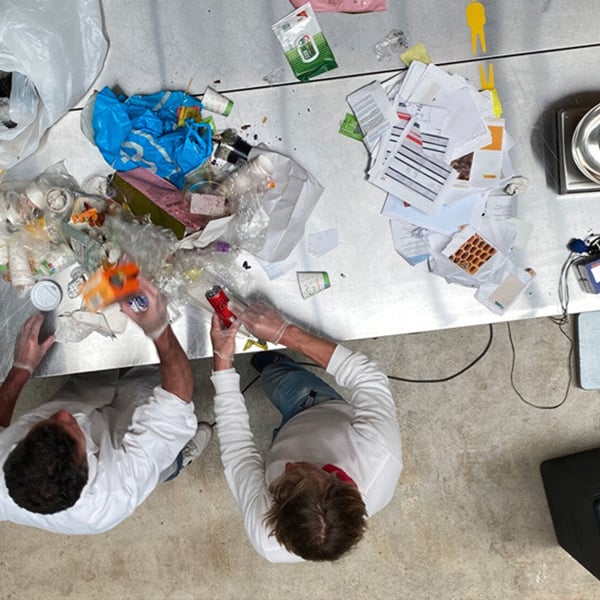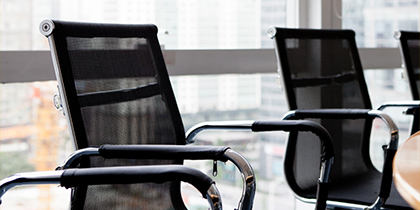Office chairs are indispensable for a comfortable workplace. By law, for example, your employer is obliged to arrange a good home office for you. And so, as a facilities employee, you are once again busy getting an office chair to your new colleague - or collecting one when someone leaves.
They can raise, lower and swivel: so you can adjust it for the right working position. But what do you do when a chair starts to wear out over time? Replacing it for a new one seems like a logical step, but is it really necessary?
We looked for a sustainable alternative. Read along.
The size of the waste stream
About 10 million tons of office furniture is thrown away every year, according to the European Environmental Bureau. Much of this furniture is office chairs, which are discarded due to wear and tear or obsolescence. But why do they disappear so quickly toward the landfill? We looked into it.
Depreciation of office chairs
Office chairs are regularly written off due to worn upholstery or a broken part such as a broken armrest or a pump that no longer works. The material often consists of a combination of metal, plastic, foam and textiles. While many of these materials are technically recyclable, in practice this rarely happens. The reason? The various materials are firmly attached to each other, making disassembly labor-intensive and costly.
Office chairs are regularly written off due to worn upholstery or a broken part such as a broken armrest or a pump that no longer works. The material often consists of a combination of metal, plastic, foam and textiles. While many of these materials are technically recyclable, in practice this rarely happens. The reason? The various materials are firmly attached to each other, making disassembly labor-intensive and costly.
Take the cushion of the chair, for example. Its contents are made of PU foam (polyurethane foam), a combination of polyols and isocyanates. During the production of the cushion, these two components are mixed. This creates a strong and flexible material. Ideal for seating comfort, but less suitable for recycling. Why? The PU foam cannot easily be reduced back to the original quality building blocks that make the foam sit so snugly. In addition, the foam is often glued to other materials, such as upholstery. These adhesive bonds ensure that the foam stays attached to the fabric. In addition, coatings are added to the cushion to keep the material resilient and extend its life. This affects the level of recycling. As a result, many office chairs end up in residual waste.
Broken office chairs at Milgro
At Milgro, we deal with numerous worn office chairs. Upholstery that is worn out and armrests that no longer work properly. Does this sound recognizable?
Instead of throwing these chairs away or taking them to the thrift store - with the chance that they will still end up in the trash, we have decided to have them repaired from now on.
For an office with a strict zero waste ambition, a logical step: We can't make the circular economy possible if we don't also use our own products longer.
Reuse and repair are important steps toward circularity, and higher on the R-ladder than recycling. This is as follows: recycling often means reprocessing materials into a new raw material. This process costs energy and sometimes results in a loss of quality of the material.
In reuse and repair, most of the original product remains intact. Instead of disposing of the entire chair, we replace only the parts that are really worn out, such as a cushion or armrest. By doing so, we reduce the waste stream and avoid buying completely new chairs, saving valuable metals, plastics, and energy.
Repair before you buy new
A sustainable choice starts at the procurement stage: before purchasing new office chairs, it is therefore wise to look into repair options. Often a small intervention - such as a new cushion, different upholstery, or a repaired armrest - can make a chair last for years again.
But repair is only the beginning. A real step toward circularity is the shift from ownership to use. That's what we're working on with partners.
To encourage repair, the European Right to Repair came into force in July 2024. The goal: to keep repairable products in use longer by requiring manufacturers to provide affordable and accessible repairs. This will make it not only easier but also more logical to give existing chairs a second life.
Want to revamp the interior and doubt whether the old office chairs will fit in? When reupholstering, you can choose new colors. Thus, a repaired chair not only gets a second life, but also a fresh and new look in the new corporate style of your company.
Zero Waste Office at Milgro
At Milgro, we consciously choose to give materials a second life - not just office chairs, but item throughout the office. We regularly get curious glances from passersby through our windows. After all, working in a greenhouse or meeting at a windmill blade is not an everyday occurrence.
Wondering how we give materials a second life in our office? Check out our office page.

Ask our experts
Not sure whether certain items in your office are unnecessarily ending up in residual waste? Our experts are here to help. Send your question tomarketing@milgro.nl and we'll get back to you with a solution for your residual waste stream.
Stay informed
Want to stay up to date with all the latest developments? Follow us on LinkedIn and Instagram or subscribe to our newsletter. Curious about what Milgro can do for you operation and waste process? Feel free to get in touch.












